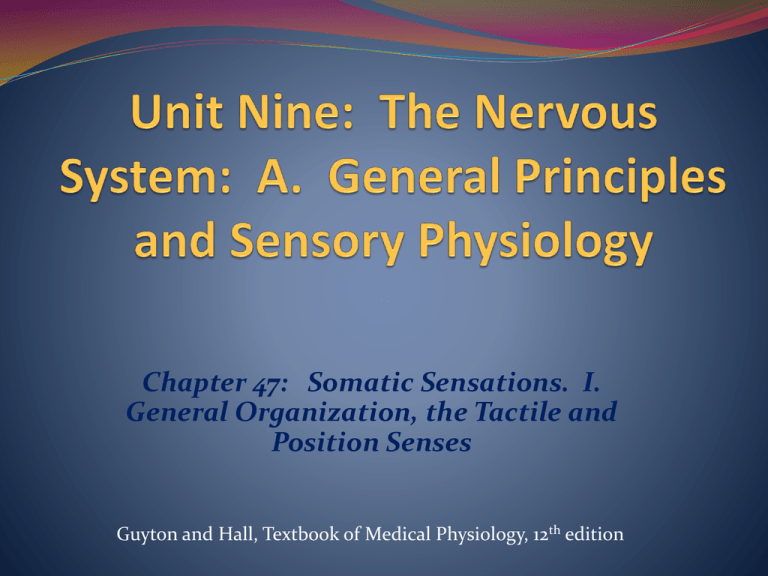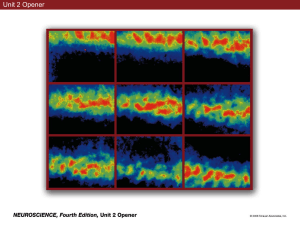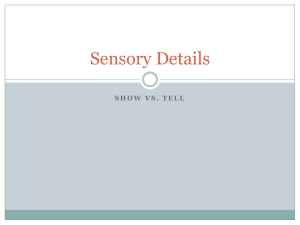Sensory Pathways for Transmitting Somatic Signals into the CNS
advertisement

Chapter 47: Somatic Sensations. I. General Organization, the Tactile and Position Senses Guyton and Hall, Textbook of Medical Physiology, 12th edition Classification of Somatic Senses • Mechanoreceptic Somatic Senses- include both tactile and position sensations stimulated by mechanical displacement • Thermoreceptive Senses- detect heat and cold • Pain Sense- activated by factors that damage tissues Other Classifications of Somatic Senses • Exteroreceptive Sensations- from the surface of the body • Proprioceptive Sensations- relating to the physical state of the body (position, tendons, muscles, equilibrium) • Visceral Sensations- sensations from the internal organs • Deep Sensations- come from the deep tissues (fascia, muscles, and bone) Detection and Transmission of Tactile Sensations • Interrelaitons Among the Tactile Sensations of Touch, Pressure, and Vibration- three principle differences a. Touch sensation generally results from stimulation of tactile receptors in the skin or s.c. tissues b. Pressure sensation generally results from deformation of deeper tissues c. Vibration sensation results from rapidly repetitive sensory signals Detection and Transmission of Tactile Sensations • Tactile Receptors a. Free nerve endings- found everywhere in the skin and in many other tissues; can detect touch and pressure b. Meissner’s Corpuscles- touch receptor with great sensitivity; elongated, encapsulated nerve ending of a large myelinated nerve fiber; present in the non-hairy areas of the skin (i.e. the fingertips) Detection and Transmission of Tactile Sensations • Tactile Receptors (cont.) c. Merkel’s discs- expanded tip tactile receptor; transmit an initially strong but partially adapting signal and then a continuing weaker signal that adapts slowly; found in the hairy parts of the skin; often grouped together in a “Iggo dome receptor” Detection and Transmission of Tactile Sensations • Tactile Receptors (cont.) Fig. 47.1 Iggo dome receptor containing multiple layers of Merkel’s discs connected to a single large myelinated nerve fiber Detection and Transmission of Tactile Sensations • Tactile Receptors (cont.) d. Hair end organ- touch receptor around each hair; movement and initial contact with the body e. Ruffini’s endings- multibranched encapsulated, adapt slowly; prolonged touch and pressure sensations; found in joint capsules Detection and Transmission of Tactile Sensations • Transmission of Tactile Signals in Peripheral Nerve Fibers • Detection of Vibration • Detection of Tickle and Itch by Mechanoreceptors Sensory Pathways for Transmitting Somatic Signals into the CNS • Dorsal Column- Medial Lemniscal System a. Touch sensations requiring high degree of localization b. Touch sensations requiring transmission of fine gradations of intensity c. Phasic sensations, such as vibratory sensations d. Sensations that signal movement against the skin e. Position sensations from the joints f. Pressure sensations related to fine degrees of judgment of pressure intensity Sensory Pathways for Transmitting Somatic Signals into the CNS • Anterolateral System a. b. c. d. e. Pain Thermal sensations, both warm and cold Crude touch and pressure Tickle and itch sensations Sexual sensations Sensory Pathways for Transmitting Somatic Signals into the CNS • Anatomy of the Dorsal Column Fig. 47.2 Sensory Pathways for Transmitting Somatic Signals into the CNS • Anatomy of the Dorsal Column Fig. 47.3 Fig. 47.4 Sensory Pathways for Transmitting Somatic Signals into the CNS • Somatosensory Cortex Fig. 47.5 Structurally distince areas, called Brodmann’s areas of the human cerebral cortex Sensory Pathways for Transmitting Somatic Signals into the CNS • Somatosensory Cortex a. Sensory signals from all modalities terminate just posterior to the central fissure b. Anterior half of the parietal lobe-reception and interpretation of somatosensory signals c. Posterior half of t he parietal lobe-provides still higher levels of interpretation d. Visual signals terminate in the occipital lobe e. Auditory signals terminate in the temporal lobe f. Anterior to the central fissure is the motor cortex Sensory Pathways for Transmitting Somatic Signals into the CNS • Somatosensory Areas I and II Fig. 47.6 Two somatosensory cortical areas; I and II Sensory Pathways for Transmitting Somatic Signals into the CNS • Spatial Orientation of Signals from Different Parts of the Body in Area I Fig. 47.7 Sensory homunculus Sensory Pathways for Transmitting Somatic Signals into the CNS • Layers of the Somatosensory Cortex and Their Functioncontains six layers of neurons (#1 is next to the brain surface) Fig. 47.8 Sensory Pathways for Transmitting Somatic Signals into the CNS • Layers of the Somatosensory Cortex and Their Function a. Incoming sensory signal excites layer IV first; signal spreads toward the surface and also deeper layers b. Layers I and II receive diffuse nonspecific input signals c. Neurons in II and III send axons to related portions of the cerebral cortex and to the opposite hemisphere via the corpus callosum d. Neurons in V and VI send axons to deeper parts of the nervous system Sensory Pathways for Transmitting Somatic Signals into the CNS • Sensory Cortex is Organized in Vertical Columns a. Each column detects a different sensory spot on the body with a specific sensory modality • Functions of Somatosensory Area I-bilateral excision cause the following types of sensory judgement: a. Person is unable to localize discretely the different sensations in different parts of the body; can localize the sensations crudely Sensory Pathways for Transmitting Somatic Signals into the CNS • Functions of Somatosensory Area I b. Person is unable to judge critical degrees of pressure against the body c. Person is unable to judge the weights of objects d. Person is unable to judge shapes or forms of objects e. Person is unable to judge texture of materials Sensory Pathways for Transmitting Somatic Signals into the CNS • Somatosensory Association Areas a. Brodmann’s Areas 5 and 7- play an important role in deciphering deeper meanings of the sensory information b. Receives information from somatosensory area I, ventrobasal nuclei of the thalamus, other areas of the thalamus, visual cortex, and the auditory cortex Sensory Pathways for Transmitting Somatic Signals into the CNS • Overall Characteristics of Signal Transmission and Analysis in the Dorsal Column- (lower part of Fig. 47.9) Fig. 47.9 Transmission of a pinpoint stimulus signal to the cerebral cortex Sensory Pathways for Transmitting Somatic Signals into the CNS • Two-Point Discrimination Fig. 47.10 Transmission of signals to the cortex from two adjacent pinpoint stimuli Sensory Pathways for Transmitting Somatic Signals into the CNS • Effect of Lateral Inhibition- increases the degree of contrast in the perceived spatial pattern a. Virtually every sensory pathway, when excited, gives rise simultaneously to lateral inhibitory signals b. Importance of lateral inhibition is that it blocks the lateral spread of excitatory signals and therefore, increases the degree of contrast in the sensory pattern perceived in the cerebral cortex c. In the dorsal column lateral inhibition signals occur at each synaptic level Sensory Pathways for Transmitting Somatic Signals into the CNS • Transmission of Rapidly Changing and Repetitive Sensations- dorsal column can recognize changing stimuli that occur in as little as 1/400 of a second • Vibratory Sensation- rapidly repetitive and can be detected up to 700 cycles/second Sensory Pathways for Transmitting Somatic Signals into the CNS • Position Senses (Proprioceptive Senses)- two subtypes: (1) static position sense, and (2) rate of movement sense (kinesthesia or dynamic proprioception) a. Knowledge of position depends on knowing the degrees of angulation of all joints in all planes and their rates of change b. Multiple different types of receptors are used: 1. Deep receptors 2. Corpuscles 3. Muscle spindles, etc. Sensory Pathways for Transmitting Somatic Signals into the CNS • Processing of Position Sense Information- thalmic neurons responding to joint rotation are of two types: a. Those maximally stimulated when the joint is at full rotation b. Those maximally stimulated when the joint is at minimal rotation Fig. 47.12 Typical responses of five different thalamic neurons when the knee joint is moved through its range of motion Transmission of Less Critical Sensory Signals in the Anterolateral Pathway • Anterolateral Pathway a. Transmits sensory signals that do not require highly discrete localization or discrimination of fine gradations of intensity 1. 2. 3. 4. 5. Pain Heat and cold Crude tactile Tickle and itch Sexual sensations Transmission of Less Critical Sensory Signals in the Anterolateral Pathway • Anatomy of the Anterolateral Pathway Fig. 47.13 Transmission of Less Critical Sensory Signals in the Anterolateral Pathway • Characteristics of Transmission a. b. c. d. Velocity of transmission is 1/3 of that of the dorsal column Degree of spatial localization of signals is poor Gradations of intensities are less accurate Ability to transmit rapidly changing or repetitive signals is poor Transmission of Less Critical Sensory Signals in the Anterolateral Pathway • Segmental Fields of Stimulation—Dermatomes •See Fig. 47.14 in the text









